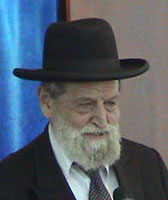Beit Midrash
- Jewish Laws and Thoughts
- Jewish Thought
- Foundations of Faith
The Torah study is dedicatedin the memory of
R. Meir b"r Yechezkel Shraga Brachfeld
This rational approach of recognizing the Creator through his creation is the one followed by Rabbi Bachya ibn Paquda in his classic work, "Duties of the Heart." He asks, "Is it possible that ink spill out onto a piece of paper and coincidentally form letters, words, sentences, and an entire composition? Is such a thing conceivable? No. If we find a piece of paper on which contains a composition, we are certain that somebody wrote it. Similarly, when we see a table, it is not reasonable to assume that a few boards coincidentally fell onto one another, stuck together, and formed a table. When one sees a table, it is clear and undeniable that somebody made it. Furthermore, according to the quality of the table, one is able to determine the proficiency of the carpenter.
If, then, simple works like these cannot be said to have coincidentally created themselves, how much more inconceivable is it to imagine the entire world, with all of its intricate design, coincidentally creating itself. Rather, the world itself serves as evidence of a Creator: "The heavens declare the glory God, the skies proclaim His handiwork" (Psalms 19:2). The skies, by their mere existence, evidence their Creator. And because our universe is the most incredible of all creations, we may conclude that its architect is also the wisest of all Creators.

Foundations of Faith (51)
Rabbi Zalman Baruch Melamed
1 - 1. Belief in God: From Design
2 - 2. Belief in God: Eyewitness Account
3 - 3. Good Intentions, Good Deeds
Load More
The Sages teach that God created our present world with one letter of the alphabet - the Hebrew letter "Heh;" the World to Come, with the letter "Yod." The intention of this metaphor is to teach us with what extreme ease God created our world. With the smallest amount effort one could imagine. The letter "Heh" is the easiest of all letters to pronounce; it is, in fact, practically silent. This great and wondrous creation which we are so impressed by, from the point of view of God and in light of His infinite ability, amounts to very little. If a person bases his faith in God on the evidence of the creation alone, his faith in God remains quite limited. Though one stands in awe of God's extraordinary creation and looks upon the heavens, as if in keeping with the verse: "Lift up your eyes to the stars, and see, Who has created these?" (Isaiah 40, 26), still, this ephemeral world of ours is nothing when viewed in light of the true ability of God.
It is not enough, then, to be satisfied with recognizing the Creator through His creation. Faith must be founded upon something even loftier that this. This, then, will serve as the focus of our next discussion.
44. The Servant of God
Rabbi Zalman Baruch Melamed | 5762
36. Well-balanced Character Traits
Rabbi Zalman Baruch Melamed | 5762





















